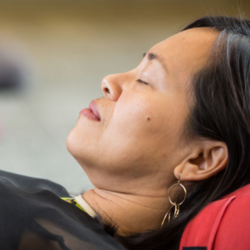his meditation provides a different lens through which to examine both the external and internal world—all that exists outside our bodies and within our bodies. Many ancient cultures believed that all things in the universe were composed of four elements—earth, water, fire, and wind—representing the qualities of solidity, cohesion, temperature, and motion.
Of course, we know through our modern scientific understanding of the material world that the universe of things is not made up of these four core elements. However, these elements and what they represent are often how we feel into ourselves, into others, and into our surroundings; bringing them to mind is a useful approach to cultivating an embodied presence.
How to do it
I invite you to find a comfortable seated position, as we investigate the Four Elements. Bring awareness to your body… the location of your body in space. The position of your head and back, the shoulders and arms, legs and feet. Feel the body sitting… the body breathing… three deep breaths… land on a natural breathing pattern as we investigate the elements.
Mindfulness in Medicine Toolkit

Click here for a list of resources you and your team can use to practice mindfulness and increase your well-being.
Earth
Begin with the earth element… solid form… Examine where and how you can feel into this solidity… This might be your skeletal structure… the bones… the lattice of you… as well as the mass of your muscles and connective tissues… the sinew… and organs… appreciate your weight, how you occupy space… your firmness… your groundedness… What gravity is acting on… This is your solid nature. Solid, like a mountain…
Water
Now let’s shift our awareness to the water element, tuning into this sense of liquidity, and cohesion. Where there is both stickiness…. as well as a flow… a sliding… and shifting… a releasing and coming together… This may be felt as moisture in the eyes, saliva in the mouth, or sweat on the body… there’s a permeability to the water element… a borderland between surfaces… where motion lives… the flow of fluid… the peristalsis in the GI tract… the pulsating of blood… the trickle of lymph… the stream of capillary beds… a thrumming in the chest…
Fire
Next, bring attention to the fire element in the body, the awareness of temperature, heat gradients, the flow of warmth away from and towards the corpus. There is motion as well in this element, a transference of energy between forms… felt at the skin, in the back of the throat, in the respiratory system… atoms in constant motion. Sense the ephemeral warmth of molecules bouncing off each other, the mitochondria of our cells… creating fuel for those cells… propelling us forward.
Wind
Finally, to the wind element, felt most prominent in the movement of air, in the body breathing. Where is this most felt? Can you appreciate spaciousness in the parts of the body that accept air, allowing in the wind that carries oxygen in and carbon dioxide out? Find the breeziness of life in these empty zones—the nostrils, the mouth, the trachea, the ear canals. Here, air flows… sometimes turbulent... other times laminar… at times nearly still… though never completely still.
As we bring our Four Elements meditation to a close, bring your attention to the body sitting… the body breathing… feel the body sitting, the sensation of gravity acting on the body. As you open your eyes, bring awareness to the sights and sounds around you, and the objects taking up space in the room.
Thank yourself for taking this time to feel into your body and sense the Four Elements living there.
This program is supported by the Health Resources and Services Administration (HRSA) of the U.S. Department of Health and Human Services (HHS). The contents are those of the author(s) and do not necessarily represent the official views of, nor an endorsement, by HRSA, HHS, or the U.S. Government. For more information, please visit HRSA.gov.
Originally published November 2023
David Sandweiss
Well-being expert and physician David Sandweiss explores the art of mindful breathing. By incorporating just three conscious breaths into our day, we can transform the way we experience the world, offering a path to clarity, calm, and a deeper connection with the present moment.
The U of U Health Resiliency Center shares a list of resources you and your team can use to practice mindfulness and increase your well-being.
With the change of the season upon us, now is a great time to focus on self-care. Well-being specialist Jamuna Jones shares her top 10 tried-and-true tips aimed at optimizing your health and nurturing your mind, body, and soul during this seasonal shift.


